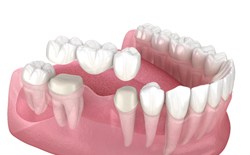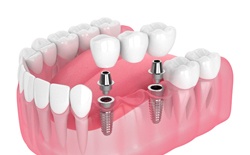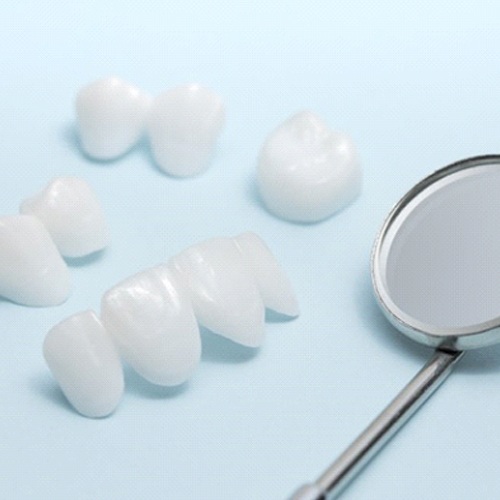Dental Bridges – Lacey, WA
Seamless Fill the Gaps In Your Smile
According to the American College of Prosthodontists, approximately 178 million people in the United States are missing at least one tooth. Although anyone at any age can have a missing tooth—the causes range from decay or injury to gum disease or cancer—the condition is more likely to occur among older people. And as more and more baby boomers march toward retirement age, the likelihood of tooth loss increases. Fortunately, we can seamlessly fill the gaps in your smile with a custom-made dental bridge in Lacey, WA. Give us a call today to schedule your next appointment and discover if this restoration is right for you!
Why Choose Peterson & Cammack Family & Cosmetic Dentistry For Dental Bridges?
- Dental Insurance Welcome
- Advanced Technology for Precise, Lifelike Results
- Start-to-Finish Dental Implant Treatment
What Is a Dental Bridge?

At Peterson & Cammack Family & Cosmetic Dentistry, we want patients to be proud of their smiles. That’s why we encourage people to take action when their smile is compromised by missing teeth. One of the best tooth replacement options for people who are missing one or more consecutive teeth is a dental bridge. For this restoration, dental crowns are secured to teeth on either side of the gap in your smile. Then, a false tooth or a series of false teeth are attached to these crowns in order to replace missing teeth. In the end, this restoration will seamlessly bridge the space where your missing tooth or teeth once more to give you a full, beautiful smile!
Types of Dental Bridges

Depending on your unique situation and preferences, you may be interested in a traditional dental bridge or an implant bridge. While these two restorations are very similar and are used to replace the same number of missing teeth, they are fundamentally different in how they’re placed. Once we’ve evaluated your unique situation, we’ll recommend one of the following.
Traditional Dental Bridges

Traditional bridges gain their support from the healthy remaining teeth that neighbor the gap in your smile. These abutment teeth will be altered to make room for dental crowns, which in turn will support a series of replacement teeth between them. While the abutment teeth will be permanently altered, a traditional dental bridge costs less time and money than an implant bridge.
Implant Bridges

Implant bridges cost more time and money than traditional bridges because they replace the roots of the teeth as well as the crowns. Two small titanium posts called dental implants are placed on either side of the space in your smile, embedded into your jawbone where they’ll fuse just like the roots of a natural tooth. Once they’ve healed into place, a dental bridge can be anchored on top of these dental implants. Not only does this leave the abutment teeth completely intact, but an implant bridge is more stable and longer-lasting than its traditional counterpart.
The Benefits of Getting a Dental Bridge

Replacing missing teeth is important to your oral health, your confidence and your overall health. Even one missing tooth that no one can see when you smile can threaten your mouth with the possibility of gum disease, shifting teeth, and an improper bite. Tooth loss can make maintaining a nutritious diet more difficult. You may not be able to enjoy fresh fruits and vegetables, which provide much needed vitamins and minerals. Finally, many people with missing teeth are reluctant to smile or talk because they know that people will see the gaping hole in their smile. Getting a dental bridge is a relatively quick and easy way to avoid all these problems and enjoy a complete set of pearly whites once again!
Dental Bridges FAQs

Do you still have questions about dental bridges? We’re more than happy to answer them! Below, we’ve gathered a few common questions about dental bridges so you can learn more about them. If you don’t see the information you’re looking for below, don’t hesitate to give us a call!
Should I get a dental bridge or denture?
We typically recommend dental bridges for patients who have a small number of consecutive missing teeth, while dentures are suggested for patients who are missing most or all their teeth. Before providing either treatment, our team will perform an exam, take X-rays, and use this information to educate you on your situation and make a recommendation. This way, you can decide what is best for you with confidence.
Are dental bridges covered by dental insurance?
Most dental insurance plans do offer partial coverage for dental bridges. They are often classified as advanced restorative care, so insurance may cover about 50% of the total cost. This is just speaking generally, however, so your policy’s numbers might look quite different. Before committing to treatment, we recommend talking to our team so we can give you an estimate of your coverage to ensure you have a more concrete idea of what you’ll be expected to pay out-of-pocket.
Is getting a dental bridge painful?
It shouldn’t be! Before preparing your teeth for a dental bridge, we’ll numb your mouth to ensure you’re completely comfortable during the procedure. While a topical anesthetic is usually all that’s needed, severely anxious patients may benefit from dental sedation. For the first few days after your dental bridge is placed, your underlying teeth may feel sensitive. Luckily, you can easily manage any discomfort with over-the-counter pain medication. If you’re getting an implant bridge, you’ll likely feel mild soreness after your oral surgery. Make sure you diligently follow your dentist’s aftercare instructions to minimize discomfort!
How long should a dental bridge last?
Most patients can expect their bridge to last anywhere between five and 15 years. Of course, the exact lifespan can vary depending on the material it’s made from. Metal bridges are typically more long-lasting than metal-free ones, although the difference is often negligible.
Aside from that, individual factors like your diet, oral hygiene, and personal habits can also affect the longevity of your dental bridge. It’s worth noting that implant bridges are known to last longer than traditional bridges. Even though the restoration itself will need to be replaced eventually, the implant posts can stay in place for decades with proper care and maintenance.
Can dental bridges be whitened?
No, your dental bridge cannot be whitened like natural teeth. Since the restoration is nonporous, whitening treatments are unable to enter and eliminate stains. If you’re interested in improving the color of your smile, ask our team about getting professional teeth whitening before dental bridge placement. That way, your restoration will be matched to the ideal shade of your teeth.
Do dental bridges feel natural?
It may take some time, but your dental bridge will eventually feel like a natural part of your smile! Not only is it designed to blend seamlessly with your remaining teeth, but it’s able to withstand the chewing of virtually any food. That means eating with a bridge shouldn’t feel strange or uncomfortable! Also, every bridge is custom-made using impressions of your natural smile, which means it should never feel awkward or noticeable. You’ll reach a point with you may even end up forgetting that you have a restoration in the first place!